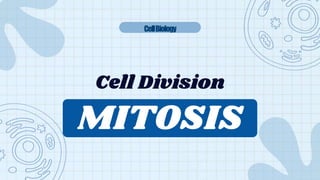Cell Division.pptxnmhvhjkbhbh.bjkb.jkjn nk
•Download as PPTX, PDF•
0 likes•3 views
chgcylvjvuh
Report
Share
Report
Share

Recommended
Recommended
More Related Content
Similar to Cell Division.pptxnmhvhjkbhbh.bjkb.jkjn nk
Similar to Cell Division.pptxnmhvhjkbhbh.bjkb.jkjn nk (20)
Cell division-mitosis-meiosis-1225581257073362-9[1]![Cell division-mitosis-meiosis-1225581257073362-9[1]](data:image/gif;base64,R0lGODlhAQABAIAAAAAAAP///yH5BAEAAAAALAAAAAABAAEAAAIBRAA7)
![Cell division-mitosis-meiosis-1225581257073362-9[1]](data:image/gif;base64,R0lGODlhAQABAIAAAAAAAP///yH5BAEAAAAALAAAAAABAAEAAAIBRAA7)
Cell division-mitosis-meiosis-1225581257073362-9[1]
CELL DIVISION- Decoding Cell Division: The Dance of Life's Continuity

CELL DIVISION- Decoding Cell Division: The Dance of Life's Continuity
Recently uploaded
This presentation intends to explore the communication of the cell within and others for sustainability along the regulation mechanisms by the cellular neural networks and others to sing the song of the life.Cellular Communication and regulation of communication mechanisms to sing the...

Cellular Communication and regulation of communication mechanisms to sing the...Nistarini College, Purulia (W.B) India
Recently uploaded (20)
Emergent ribozyme behaviors in oxychlorine brines indicate a unique niche for...

Emergent ribozyme behaviors in oxychlorine brines indicate a unique niche for...
GBSN - Microbiology (Unit 6) Human and Microbial interaction

GBSN - Microbiology (Unit 6) Human and Microbial interaction
ERTHROPOIESIS: Dr. E. Muralinath & R. Gnana Lahari

ERTHROPOIESIS: Dr. E. Muralinath & R. Gnana Lahari
Cellular Communication and regulation of communication mechanisms to sing the...

Cellular Communication and regulation of communication mechanisms to sing the...
In-pond Race way systems for Aquaculture (IPRS).pptx

In-pond Race way systems for Aquaculture (IPRS).pptx
Exomoons & Exorings with the Habitable Worlds Observatory I: On the Detection...

Exomoons & Exorings with the Habitable Worlds Observatory I: On the Detection...
Biochemistry and Biomolecules - Science - 9th Grade by Slidesgo.pptx

Biochemistry and Biomolecules - Science - 9th Grade by Slidesgo.pptx
Jet reorientation in central galaxies of clusters and groups: insights from V...

Jet reorientation in central galaxies of clusters and groups: insights from V...
Manganese‐RichSandstonesasanIndicatorofAncientOxic LakeWaterConditionsinGale...

Manganese‐RichSandstonesasanIndicatorofAncientOxic LakeWaterConditionsinGale...
Detectability of Solar Panels as a Technosignature

Detectability of Solar Panels as a Technosignature
PLANT DISEASE MANAGEMENT PRINCIPLES AND ITS IMPORTANCE

PLANT DISEASE MANAGEMENT PRINCIPLES AND ITS IMPORTANCE
WASP-69b’s Escaping Envelope Is Confined to a Tail Extending at Least 7 Rp

WASP-69b’s Escaping Envelope Is Confined to a Tail Extending at Least 7 Rp
Cell Division.pptxnmhvhjkbhbh.bjkb.jkjn nk
- 2. 01 · Cell 02 · Cell Division 03 · Mitosis 04 · Interphase 05 · Prophase 06 · Metaphase 07 · Anaphase 08 . Telophase 09 . Cytokinesis Tableofcontent
- 3. It is the smallest unit that contains all living beings; our body is composed of billions of them. 1 Like all living things, they perform vital functions: they are born; they are feed to grow and carry out their functions; such as reproduction and death. 2 They contain hereditary material and can make copies of themselves hrough two processes called mitosis and meiosis. 3 Cell
- 4. Cell Division It is a fundamental process to create life, occurring in all forms of it, ensuring the perpetuity of their existence, as well as growth, tissue replacement, and reproduction in multicellular organisms. It is known as cell reproduction or cell division, is the stage in the cell cycle where each cell divides to form two daughter cells. There are three biological mechanisms of cell reproduction: binary fission, meiosis, and mitosis.
- 5. Binary fission Meiosis Mitosis Cell Division
- 6. It is the most common form of cell division in somatic eukaryotic cells (those that will not become sex cells). 1 2 When mitosis is completed, two genetically identical cells are produced. It is a fundamental process during growth and tissue repair. Mitosis
- 7. Mitosi s
- 8. Interphase A cell divides into two daughter cells that can then divide again, creating a cycle of cell division. The period between two consecutive mitoses is called interphase. As the cell prepares for reproduction, it duplicates its DNA and takes the necessary internal and external measures to successfully undergo the process. Centrosome Deoxyribonucleic Acid (DNA)
- 9. Centrosome Microtubules Chromosomes Prophase Chromatin undergoes progressive condensation due to supercoiling, resulting in the formation of chromosomes. The nuclear envelope starts to break down, gradually dissolving. The centrosome duplicates, and each one moves to one of the cell's ends, where microtubules are formed.
- 10. Centrosome Microtubules Chromosome Metaphase The chromosomes align at the cell's equator during metaphase, with the fibers of the mitotic spindle. Each chromosome has already duplicated during interphase, so at this point, the two copies separate. Centromere Microtubules attach to each centromere of the chromosomes.
- 11. Centrosome Microtubules Chromosome Anaphase It is the crucial phase of mitosis because it is when the distribution of the original genetic information occurs. The two groups of chromosomes (which are identical) move apart thanks to the microtubules toward opposite poles of the cell. Each set of genetic information concentrates around a centrosome.
- 12. Centrosome Microtubules Telophase The microtubules that aided in the migration of the two groups of chromosomes disappear. Two new nuclear envelopes begin to form, each containing the information for each new cell. The chromosomes start to decondense, exposing the DNA and initiating the processes characteristic of an independent cell. Deoxyribonucleic Acid (DNA)
- 13. Cytokinesis It involves the physical separation of the cytoplasm. A contractile ring composed of actin and myosin microfilaments forms, constricting the cell and creating a structure resembling an hourglass. A cleavage furrow forms, ultimately separating the two daughter cells, each with the same number of chromosomes as the parent cell. Contractile ring
- 14. Mitosi s